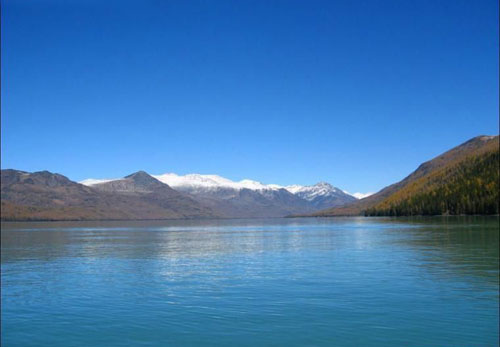Kanas Nature Reserve
|
|
|
The Kanas Nature Reserve on this undated photo. |
In Mongolian, "Kanas" means "fair, rich and mysterious land". Covering an area of about 10,000 square kilometres, the Kanas Nature Reserve is bordered by China, Kazakhstan, Russia and Mongolia.
The area is full of natural scenery, from glaciers and snow capped mountains to grasslands and wetlands. It has also been suggested as the only gene bank of cold temperate zone fauna and flora in the world.
Zhao Yuxia is director of the local tourism bureau and the Kanas Nature Reserve management committee.
"Beautiful and mysterious, the Kanas nature reserve has lots of natural geological scenery. An environmental official from the United Nations said after inspecting the area in 1995 that Kanas was the last treasure land to be developed."
Zhao Yuxia says Kanas is popular both at home and abroad because it has several unique characteristics.
"Kanas is the only place in China where West Siberian taiga forests are found. It has the largest Palaearctic European and Siberian fauna and flora varieties and is the only flora gene bank in China. The area is also the source of the Burqin, the largest tributary of the Irtysh River."
Main scenic spots along the Kanas River include lakes, bays, villages and a pavilion. One of its four bays is called the Camel Neck. The Kanas River has several river bends and its riverbed forms an "s" shape at the Camel Neck Bay, which is how it got its name.
Zhao Yuxia says the Camel Neck is the last of the four bays.
"Visitors usually first come to the other three bays, namely Crouching Dragon, Moon, and Fairy. They each feature grasslands, rocks, and ponds."
The Kanas River originates from the Altai Mountain. Stretching 125 kilometres from northeast to southwest, the River is the only one in China which runs into the Arctic Ocean. Birches grow on both sides of the river, and in autumn, its leaves turn golden.
Downstream, visitors come to the Kanas Lake, which attracts the public for its legendary monster.
Shaped like a crescent moon, the lake covers 4,500 square kilometres and is 188 meters deep. The colour of its surface changes with the season, winning it the name of "colour-changing lake".
Zhao Yuxia explains.
"In just 30 minutes drive by boat, we will come to the place where the lake monster was spotted. It's also the deepest area in the lake."
By the lake, there is another popular scenic spot, the Fish Watching Pavilion. Located on a hill, the pavilion has an elevation of about 2,000 meters. When you look down from it, you can take in the entire scenic area.
The Kanas Nature Reserve is a paradise for rare animals. You can find sable, wolverine and snow leopard, all rare animals under state protection. There are also goshawks and sparrow-hawks, which are under state protection.
Recently, a large sum of money has been allocated for the protection of the nature reserve and construction of basic facilities. More tourism programs have been added including rafting, boating and mountaineering.
Xiao Yong is a tourist from Chengdu in southwest China.
"I came with my family. We drifted this afternoon and it was exciting and a lot of fun. The water in the lake is so clean and clear. We'll come next year."
A geological park was opened earlier this year in the nature reserve. Local tourism official Zhao Yuxia again.
"The scenery varies in four seasons. There are green grasses in spring, flowers in summer, red leaves in autumn and ice and snow in winter."
Zhao Yuxia says the people in Kanas are hospitable and they are always ready to receive guests from home and abroad.
 0 Comments
0 Comments








Comments